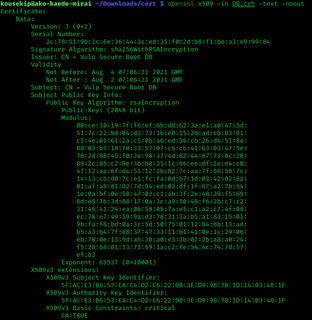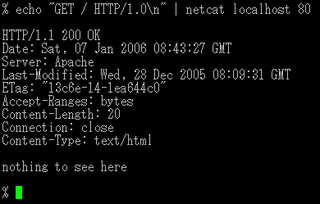
In computer networking, a proxy server is a server application that acts as an intermediary between a client requesting a resource and the server providing that resource.

Squid is a caching and forwarding HTTP web proxy. It has a wide variety of uses, including speeding up a web server by caching repeated requests, caching web, DNS and other computer network lookups for a group of people sharing network resources, and aiding security by filtering traffic. Although primarily used for HTTP and FTP, Squid includes limited support for several other protocols including Internet Gopher, SSL, TLS and HTTPS. Squid does not support the SOCKS protocol, unlike Privoxy, with which Squid can be used in order to provide SOCKS support.

Internet Information Services is an extensible web server software created by Microsoft for use with the Windows NT family. IIS supports HTTP, HTTP/2, HTTPS, FTP, FTPS, SMTP and NNTP. It has been an integral part of the Windows NT family since Windows NT 4.0, though it may be absent from some editions, and is not active by default.
In cryptography, a public key certificate, also known as a digital certificate or identity certificate, is an electronic document used to prove the validity of a public key. The certificate includes information about the key, information about the identity of its owner, and the digital signature of an entity that has verified the certificate's contents. If the signature is valid, and the software examining the certificate trusts the issuer, then it can use that key to communicate securely with the certificate's subject. In email encryption, code signing, and e-signature systems, a certificate's subject is typically a person or organization. However, in Transport Layer Security (TLS) a certificate's subject is typically a computer or other device, though TLS certificates may identify organizations or individuals in addition to their core role in identifying devices. TLS, sometimes called by its older name Secure Sockets Layer (SSL), is notable for being a part of HTTPS, a protocol for securely browsing the web.
Virtual hosting is a method for hosting multiple domain names on a single server. This allows one server to share its resources, such as memory and processor cycles, without requiring all services provided to use the same host name. The term virtual hosting is usually used in reference to web servers but the principles do carry over to other Internet services.

OpenSSL is a software library for applications that secure communications over computer networks against eavesdropping or need to identify the party at the other end. It is widely used by Internet servers, including the majority of HTTPS websites.

netcat is a computer networking utility for reading from and writing to network connections using TCP or UDP. The command is designed to be a dependable back-end that can be used directly or easily driven by other programs and scripts. At the same time, it is a feature-rich network debugging and investigation tool, since it can produce almost any kind of connection its user could need and has a number of built-in capabilities.

lighttpd is an open-source web server optimized for speed-critical environments while remaining standards-compliant, secure and flexible. It was originally written by Jan Kneschke as a proof-of-concept of the c10k problem – how to handle 10,000 connections in parallel on one server, but has gained worldwide popularity. Its name is a portmanteau of "light" and "httpd".
In computer networks, a tunneling protocol is a communication protocol which allows for the movement of data from one network to another, by exploiting encapsulation. It involves allowing private network communications to be sent across a public network through a process called encapsulation.
Web server software allows computers to act as web servers. The first web servers supported only static files, such as HTML, but now they commonly allow embedding of server side applications.

HTTP compression is a capability that can be built into web servers and web clients to improve transfer speed and bandwidth utilization.
Pound is a lightweight open source reverse proxy program and application firewall suitable to be used as a web server load balancing solution. Developed by an IT security company, it has a strong emphasis on security. The original intent on developing Pound was to allow distributing the load among several Zope servers running on top of ZEO. However, Pound is not limited to Zope-based installations. Using regular expression matching on the requested URLs, Pound can pass different kinds of requests to different backend server groups. A few more of its most important features:
Mongrel is an open-source software HTTP library and web server written in Ruby by Zed Shaw. It is used to run Ruby web applications and presents a standard HTTP interface. This makes layering other servers in front of it possible using a web proxy, a load balancer, or a combination of both, instead of having to use more conventional methods employed to run scripts such as FastCGI or SCGI to communicate. This is made possible by integrating a custom high-performance HTTP request parser implemented using Ragel.

HTTP 403 is an HTTP status code meaning access to the requested resource is forbidden. The server understood the request, but will not fulfill it.
HTTP tunneling is used to create a network link between two computers in conditions of restricted network connectivity including firewalls, NATs and ACLs, among other restrictions. The tunnel is created by an intermediary called a proxy server which is usually located in a DMZ.
Server Name Indication (SNI) is an extension to the Transport Layer Security (TLS) computer networking protocol by which a client indicates which hostname it is attempting to connect to at the start of the handshaking process. This allows a server to present one of multiple possible certificates on the same IP address and TCP port number and hence allows multiple secure (HTTPS) websites to be served by the same IP address without requiring all those sites to use the same certificate. It is the conceptual equivalent to HTTP/1.1 name-based virtual hosting, but for HTTPS. This also allows a proxy to forward client traffic to the right server during TLS/SSL handshake. The desired hostname is not encrypted in the original SNI extension, so an eavesdropper can see which site is being requested.
The front controller software design pattern is listed in several pattern catalogs and is related to the design of web applications. It is "a controller that handles all requests for a website," which is a useful structure for web application developers to achieve flexibility and reuse without code redundancy.

Rack is a modular interface between web servers and web applications developed in the Ruby programming language. With Rack, application programming interfaces (APIs) for web frameworks and middleware are wrapped into a single method call handling HTTP requests and responses.
mod_proxy is an optional module for the Apache HTTP Server.

Cherokee is an open-source cross-platform web server that runs on Linux, BSD variants, Solaris, OS X, and Windows. It is a lightweight, high-performance web server/reverse proxy licensed under the GNU General Public License. Its goal is to be fast and fully functional yet still light. Major features of Cherokee include a graphical administration interface named cherokee-admin, and a modular light-weight design.









